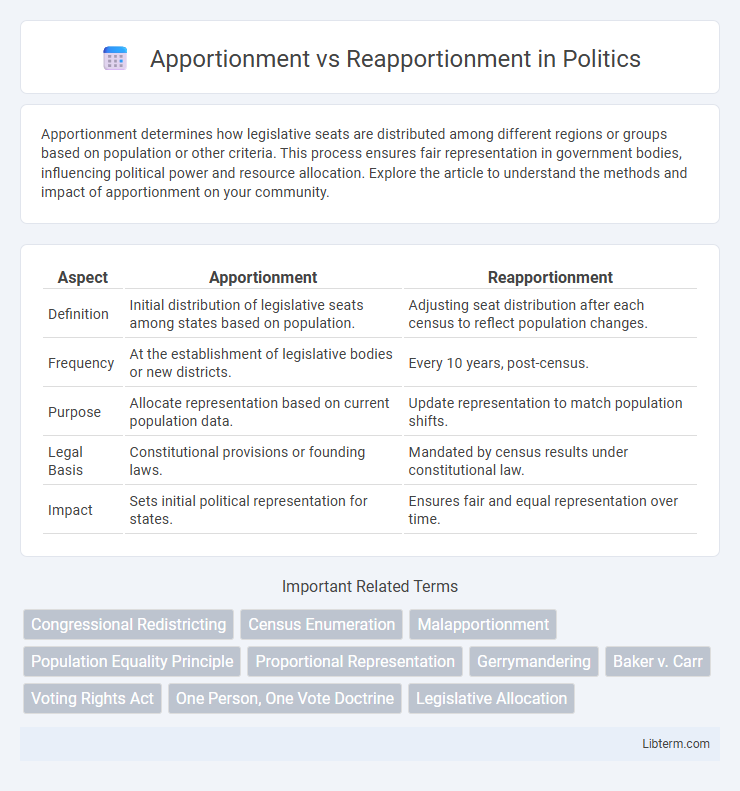Apportionment determines how legislative seats are distributed among different regions or groups based on population or other criteria. This process ensures fair representation in government bodies, influencing political power and resource allocation. Explore the article to understand the methods and impact of apportionment on your community.
Table of Comparison
| Aspect | Apportionment | Reapportionment |
|---|---|---|
| Definition | Initial distribution of legislative seats among states based on population. | Adjusting seat distribution after each census to reflect population changes. |
| Frequency | At the establishment of legislative bodies or new districts. | Every 10 years, post-census. |
| Purpose | Allocate representation based on current population data. | Update representation to match population shifts. |
| Legal Basis | Constitutional provisions or founding laws. | Mandated by census results under constitutional law. |
| Impact | Sets initial political representation for states. | Ensures fair and equal representation over time. |
Introduction to Apportionment and Reapportionment
Apportionment refers to the process of distributing legislative seats among political subdivisions based on population data, typically derived from the decennial census. Reapportionment involves the periodic adjustment of these seat allocations to reflect population shifts and maintain equitable representation. Both processes are essential in ensuring proportional representation within legislative bodies such as the U.S. House of Representatives.
Defining Apportionment: Meaning and Purpose
Apportionment refers to the process of distributing legislative seats among electoral districts based on population data, ensuring representative democracy by aligning political power with demographic changes. It serves to allocate representation fairly after each census, reflecting shifts in population density and maintaining equal voting power. This mechanism is fundamental to upholding the principle of "one person, one vote" in political systems.
What is Reapportionment? Key Concepts
Reapportionment is the process of redistributing the 435 seats in the U.S. House of Representatives based on updated population data from the decennial census, ensuring each state is fairly represented according to population shifts. Key concepts include the use of the Census Bureau's population counts, the Equal Proportion Method for seat allocation, and the legal mandate to conduct reapportionment every ten years. This process directly impacts political representation and federal funding allocation among states.
Historical Background of Apportionment
Apportionment originated with the U.S. Constitution's mandate to allocate House of Representatives seats based on population, first established in 1790 following the initial federal census. Historically, apportionment has relied on decennial census data to ensure proportional representation among states, reflecting demographic shifts and population growth. This process laid the groundwork for the modern political system by balancing congressional representation according to population changes documented through the census.
Legal Framework Governing Apportionment and Reapportionment
The legal framework governing apportionment and reapportionment is primarily established by the U.S. Constitution, specifically Article I, Section 2, and reinforced by federal statutes such as the Reapportionment Act of 1929. Apportionment determines the allocation of House seats to states based on population data from the decennial census, while reapportionment involves redistributing these seats among states following each census. Judicial oversight, including landmark Supreme Court cases like Wesberry v. Sanders, ensures that both processes comply with the principle of equal representation, adhering to "one person, one vote" standards.
Process and Methods of Apportionment
Apportionment is the process of distributing legislative seats among districts or states based on population, while reapportionment involves the redistribution of seats after each decennial census to reflect population changes. Methods of apportionment include the Hamilton method, which uses largest remainder, and divisor methods like Jefferson and Webster, which allocate seats by dividing population by a standard divisor. These methods aim to ensure proportional representation by minimizing disparities in seat allocation relative to population size.
How Reapportionment is Conducted
Reapportionment is conducted by reallocating the number of seats each state receives in the U.S. House of Representatives based on decennial census population data. The process uses the Method of Equal Proportions to ensure each congressional district represents an approximately equal number of constituents. This adjustment reflects population shifts and maintains proportional representation across states every ten years.
Key Differences Between Apportionment and Reapportionment
Apportionment refers to the initial allocation of legislative seats based on population data, usually conducted after a census, while reapportionment involves redistributing those seats due to population shifts over time. Apportionment establishes the baseline representation for a newly formed legislative body, whereas reapportionment adjusts the existing representation to reflect demographic changes. The key difference lies in apportionment being the original division of seats, and reapportionment being the periodic recalibration of those seats among constituencies.
Impact on Representation and Government
Apportionment allocates legislative seats based on population data, directly affecting the balance of representation in government by ensuring districts reflect current demographics. Reapportionment occurs after each census, adjusting the number of seats per state or district to respond to population shifts and maintain equitable political influence. These processes impact legislative power distribution, resource allocation, and policy priorities within federal and state governments.
Challenges and Controversies in Apportionment and Reapportionment
Apportionment faces challenges such as population shifts, census inaccuracies, and legal disputes that impact fair representation. Reapportionment controversies often stem from gerrymandering, demographic changes, and political manipulation, which can distort electoral outcomes. These issues raise concerns over equal representation and the integrity of democratic processes.
Apportionment Infographic

 libterm.com
libterm.com